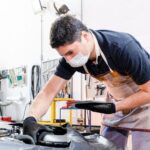Emergency braking may become necessary due to various reasons, including road hazards or vehicles ahead that stop suddenly and abruptly. Your car must stop as soon as possible in order to avoid an accident; so check out which factors impact directly upon its speed of stopping as well as methods you can employ to decrease stopping distance and steps you can take to prolong it.
Speed
Two elements come together to determine stopping distance: thinking and brake distance. “Thinking distance” refers to how much time a driver needs from seeing an obstacle until using his or her brakes, depending on their rate of information processing.
“Braking distance” refers to the amount of space covered when applying brakes until you come to a complete stop. Speed plays an integral role; simply stated, driving faster means traveling further after applying brakes until the car stops completely.
Brake mechanism & performance
Anti-lock brakes (ABS) are common on modern automobiles but do not significantly decrease stopping distance. On the other hand, anti-lock brakes allow drivers to maintain control over their vehicle in emergency braking situations and emergency braking situations. Regular maintenance and optimal performance of your brakes is key; so make sure they’re checked when installing brand-new Tyres Sharjah.
Performance and mechanism are heavily impacted by road conditions. Slippery or icy roads extend stopping distance, while driving through deep puddles of water can reduce stopping distance drastically. If driving slowly through these waterlogged spots, press both brake pedals multiple times while driving slowly to dry them off and ensure optimal long-term performance of your brakes.
Tyre Pressure
For optimal stopping distance, tyres must contact the road as much as possible. Incorrect pressure or inflation levels may damage tread patches, which in turn affects brake performance, driving performance and stopping distance.
Uneven and frequent tread wear are other causes that could contribute to tyre blowouts or road-related accidents, while its pressure can be controlled precisely using information printed on each tire or the driver’s doorjamb of a vehicle.
Worn Tyres
Federal law mandates that worn tyres be replaced when their tread depth drops to below 1.6mm, or else driving on them can severely compromise stopping distance and increase risk of collision. If this situation exists for you, do not continue driving as this may increase stopping distance and risk of accident significantly.
Most tyres come equipped with an 8mm tread size. Over time this wears away quickly when driving on unforgiving roads and driving mistreated, especially if on rougher surfaces. Driving with worn tread depth may lead to an excessive fine or cancellation of license in some states!
Quality of the Tyres
When purchasing high-quality Dunlop tires in Sharjah from trusted brands like Falken, they come with confidence and unrivaled performance that guarantees an enjoyable road trip. As well as quality, make sure that they fit according to seasonal variations such as winter or summer; each can significantly impact stopping distance.






